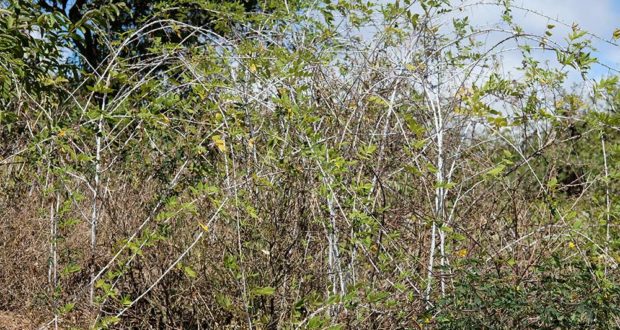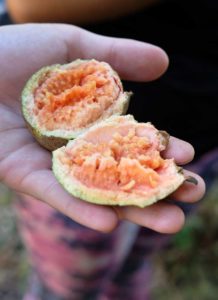As my plane approached San Cristobal, a flight attendant went down the aisle spraying the overhead luggage compartment to kill anything I might have brought from the mainland. When I prepared to board a boat to Espanola, military personnel were on hand to make certain I stepped onto a large sponge of pesticide and herbicide to keep me from transporting species between islands. In another program, hunters famously took to helicopters to shoot the goats roaming the countryside.
Certainly all of the native species on the Galapagos arrived uninvited at some point, albeit quite long ago. The common thread of these newer visitors is that they were brought to the islands intentionally or unintentionally by people, and they now pose an environmental or economic threat to the native populations.On an excursion to the highlands, invasive plants were everywhere. Orange and guava (Psidium guajava) trees laden with fruit marked the remnants of defunct orchards. Elephant grass (Pennisetum purpureum) brought in to support foraging cattle filled the meadows. Thorny blackberry bushes (Rubus niveus) were everywhere, completely covering the ground in places to the exclusion of everything else, but giving my colleagues a chance to put their dull machete to work.
(I have to confess, there were some aspects of the invasives that I enjoyed. Freshly picked orange and guava along the trail – literally low hanging fruit – were delicious, and back in Puerto Baquerizo Moreno the blackberry pastries and blackberry ice cream were irresistible.)
Many of the invasive species were brought in intentionally to fulfill a need or attack a problem. I was saddened to learn that the beautiful Smooth-billed Ani (Crotophaga ani), which I assumed was a native, reportedly was introduced to the islands by ranchers in the 1970s in the mistaken belief that the birds would purge their cattle of ticks. Larger and stronger than finches and mockingbirds, they compete aggressively with the native birds for insects and lava lizards. The Ani, shimmering midnight black birds with an enormous bill and long tail, have become widespread across the Galapagos.
Cuban Cedar trees (Cedrela Odorata), which grow taller and have a longer life cycle than many of their native counterparts, were introduced to the islands in the last century as a source of quality timber. They have since developed into fairly dense forests on Santa Cruz and San Cristobal, displacing the native Scalesia pedunculata in part by producing a chemical that suppresses their development.
Despite all of these challenges, the Galapagos remain a relatively pristine ecosystem. Of the 4,000 native species on the islands, fewer than 20 have gone extinct, but many of them now are considered threatened or vulnerable.

